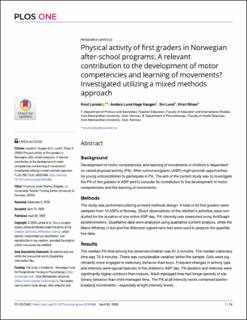| dc.contributor.author | Løndal, Knut | |
| dc.contributor.author | Haugen, Anders L. Hage | |
| dc.contributor.author | Lund, Siv | |
| dc.contributor.author | Riiser, Kirsti | |
| dc.coverage.spatial | Norway | en_US |
| dc.date.accessioned | 2021-09-10T10:26:57Z | |
| dc.date.available | 2021-09-10T10:26:57Z | |
| dc.date.created | 2020-05-01T11:33:29Z | |
| dc.date.issued | 2020-04-30 | |
| dc.identifier.citation | PLOS ONE. 2020, 15 (4), . | en_US |
| dc.identifier.issn | 1932-6203 | |
| dc.identifier.uri | https://hdl.handle.net/11250/2775194 | |
| dc.description.abstract | Background: Development of motor competencies and learning of movements in children is dependent
on varied physical activity (PA). After-school programs (ASP) might provide opportunities for young schoolchildren to participate in PA. The aim of the current study was to investigate the PA of first graders in ASP and to consider its contribution to the development of motor competencies and the learning of movements. Methods: The study was performed utilizing a mixed methods design. A total of 42 first graders were sampled from 14 ASPs in Norway. Direct observations of the children’s activities were conducted for the duration of one entire ASP day. PA intensity was measured using ActiGraph accelerometers. Qualitative data were analyzed using qualitative content analysis, while the Mann-Whitney U test and the Wilcoxon signed-rank test were used to analyze the quantitative data. Results: The median PA time among the observed children was 61.5 minutes. The median stationary time was 75.9 minutes. There was considerable variation within the sample. Girls were significantly more engaged in stationary behavior than boys. Frequent changes in activity type and intensity were typical features of the children’s ASP day. PA duration and intensity were significantly higher outdoors than indoors. Adult-managed time had longer periods of stationary behavior than child-managed time. The PA at all intensity levels contained barrier-breaking movements—especially at light intensity levels. Conclusion: Most of the first graders studied were engaged in a variety of activity types of different duration and intensity levels, favorable for the development of motor competencies and for the learning of movements. Hence, it is reasonable to highlight that light PA, in combination with moderate and vigorous PA, is also of great importance for children during the time they spend in ASP. Ultimately, there is a need for staff members who can also stimulate varied PA among the most stationary children. | en_US |
| dc.description.sponsorship | The study is funded by - Norwegian Fund for Postgraduate Training in Physiotherapy (http://fysiofondet.no/) - Oslo Metropolitan University (https://www.oslomet.no/en/english). | en_US |
| dc.language.iso | eng | en_US |
| dc.publisher | Public Library of Science | en_US |
| dc.relation.ispartofseries | PLOS ONE;15 (4): e0232486 | |
| dc.rights | Navngivelse 4.0 Internasjonal | * |
| dc.rights.uri | http://creativecommons.org/licenses/by/4.0/deed.no | * |
| dc.subject | Physical activities | en_US |
| dc.subject | Children | en_US |
| dc.subject | Equipment | en_US |
| dc.subject | Accelerometers | en_US |
| dc.subject | Human learning | en_US |
| dc.subject | Sports | en_US |
| dc.subject | Schools | en_US |
| dc.title | Physical activity of first graders in Norwegian after-school programs: A relevant contribution to the development of motor competencies and learning of movements? Investigated utilizing a mixed methods approach | en_US |
| dc.type | Peer reviewed | en_US |
| dc.type | Journal article | en_US |
| dc.description.version | publishedVersion | en_US |
| dc.rights.holder | © 2020 Løndal et al. | en_US |
| dc.source.articlenumber | e0232486 | en_US |
| cristin.ispublished | true | |
| cristin.fulltext | original | |
| cristin.qualitycode | 1 | |
| dc.identifier.doi | https://doi.org/10.1371/journal.pone.0232486 | |
| dc.identifier.cristin | 1809020 | |
| dc.source.journal | PLOS ONE | en_US |
| dc.source.volume | 15 | en_US |
| dc.source.issue | 4 | en_US |
| dc.source.pagenumber | 16 | en_US |

